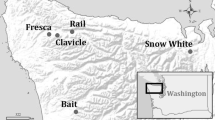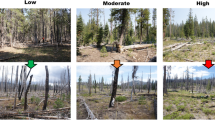Abstract
Clearcutting is a common silvicultural practice in the deciduous forests of northern New England. Subsequent regrowth is usually rapid, largely due to regenerative capacities of successional plants, particularly pin cherry (Prunus pensylvanica L.). The forest cover of an experimental watershed (W2) in Hubbard Brook Experimental Forest, NH was clearcut and then treated with herbicides for 3 years to prevent regrowth. This experimental treatment delayed plant growth and caused extensive nutrient losses from the watershed-ecosystem, thereby diminishing factors normally promoting revegetation. This article addresses the question of whether, or to what degree, resilience, defined here as the trajectory of recovery back to a prior state following a perturbation, was reduced by this treatment. Performance metrics for resilience were aboveground net primary productivity (ANPP) and biomass accumulation. Data collected over seven intervals for the first 31 years of regrowth show that a primary component of resilience—pin cherry density—was reduced, and that ANPP and biomass accumulation were initially below normal compared with other clear-cut sites. After approximately a decade of regrowth, however, trajectories for both ANPP and biomass fell within the lower margins of variability measured in other regional examples.








Similar content being viewed by others
References
Arthur MA, Tritton LM, Fahey TJ. 1993. Dead bole mass and nutrients remaining 23 years after clear-felling of a northern hardwood forest. Canadian Journal of Forest Research 23:1298–305.
Boring LR, Swank WT, Monk CD. 1988. Dynamics of early successional forest structure and processes in the Coweeta Basin. In: Swank, WT, Crossley DA, Eds. Forest hydrology and ecology at Coweeta. Ecological Studies 66. New York: Springer. pp 161–78.
Bormann FH, Siccama TG, Likens GE, Whittaker RH. 1970. The Hubbard Brook ecosystem study: composition and dynamics of the tree stratum. Ecological Monographs 40:373–88.
Bormann FH, Likens GE. 1979. Pattern and process in a forested ecosystem. New York: Springer. p 253.
Carpenter S, Walker B, Anderies JM, Abel N. 2001. From metaphor to measurement: resilience of what to what? Ecosystems 4:765–81.
Fahey TJ, Battles JJ, Wilson GF. 1998. Responses of early successional northern hardwood forests to changes in nutrient availability. Ecological Monographs 68:183–212.
Fahey TJ, Siccama TG, Driscoll CT, Likens GE, Campbell J, Johnson CE, Battles JJ, Aber JD, Cole JJ, Fisk MC, Groffman PM, Hamburg SP, Holmes RT, Schwarz PA, Yanai RD. 2005. The biogeochemistry of carbon at Hubbard Brook. Biogeochemistry 75:109–76.
Folke C, Carpenter S, Walker B, Scheffer M, Elmqvist T, Gunderson L, Holling CS. 2004. Regime shifts, resilience, and biodiversity in ecosystem management. Annual Review of Ecology, Evolution and Systematics 35:557–81.
Forcier LK. 1975. Reproductive strategies and the co-occurrence of climax tree species. Science 189:808–10.
Halpern CB. 1988. Early successional pathways and the resistance and resilience of forest communities. Ecology 69:1703–15.
Hamilton EH, Haeussler S. 2008. Modeling stability and resilience after slashburning across a sub-boreal to subalpine forest gradient in British Columbia. Canadian Journal of Forest Research 38:304–16.
Hendrickson OW. 1988. Biomass and nutrients in regenerating woody vegetation following whole-tree and conventional harvest in a northern mixed forest. Canadian Journal of Forest Research 18:1427–36.
Holling CS. 1996. Surprise for science, resilience for ecosystems, and incentives for people. Ecological Applications 6:735.
Irland LC. 1998. Ice storm 1998 and the forests of the northeast. Journal of Forestry 96:32–40.
Irland LC. 2000. Ice storms and forest impacts. The Science of the Total Environment 262:231–42.
Johnson CE, Driscoll CT, Fahey TJ, Siccama TG, Hughes JW. 1995. Carbon dynamics following clear-cutting of a northern hardwood forest ecosystem. In: Kelly JM, McFee WW, Eds. Carbon: forms and functions in forest soils. Madison, WI: American Society of Agronomy. pp 463–88.
Johnson CE, Driscoll CT, Siccama TG, Likens GE. 2000. Element fluxes and landscape position in a northern hardwood forest watershed ecosystem. Ecosystems 3:159–84.
Likens GE, Bormann FH, Pierce RS, Reiners WA. 1978. Recovery of a deforested ecosystem. Science 199:492–6.
Likens GE, Dresser BK, Buso DC. 2004. Short-term temperature response in forest floor and soil to ice storm disturbance in a northern hardwood forest. Northern Journal of Applied Forestry 21:209–19.
Marks PL. 1974. The role of pin cherry (Prunus pensylvanica L.) in the maintenance of stability in northern hardwood ecosystems. Ecological Monographs 44:73–88.
Marks PL, Bormann FH. 1972. Revegetation following forest cutting: mechanisms for return to steady-state nutrient cycling. Science 176:914–15.
Martin CW, Bailey AS. 1999. Twenty years of change in a northern hardwood forest. Forest Ecology and Management 123:253–60.
Mou PU, Fahey TJ, Hughes JW. 1993. Effects of soil disturbance on vegetation recovery and nutrient accumulation following whole-tree harvest of a northern hardwood ecosystem. Journal of Applied Ecology 30:661–75.
Odum EP. 1969. The strategy of ecosystem development. Science 164:262–70.
Ollinger SV, Aber JD, Lovett GM, Millham SE, Lathrop RG, Ellis JM. 1993. A spatial model of atmospheric deposition for the northeastern U.S. Ecological Applications 3:459–72.
Reiners WA. 1988. Achievements and challenges in forest energetics. In: Pomeroy LR, Alberts JJ, Eds. Concepts of ecosystem ecology. New York: Springer. pp 75–114.
Reiners WA. 1992. Twenty years of ecosystem reorganization following experimental deforestation and regrowth suppression. Ecological Monographs 62:503–23.
Rhoads AG, Hamburg SP, Fahey TJ, Siccama TG, Hane EN, Battles J, Cogbill C, Randall J, Wilson G. 2002. Effects of an intense ice storm on the structure of a northern hardwood forest. Canadian Journal of Forest Research 32:1763–75.
Rydgren K, Økland RH, Hestmark G. 2004. Disturbance severity and community resilience in a boreal forest. Ecology 85:1906–15.
Safford LO, Filip SM. 1974. Biomass and nutrient content of 4-year-old fertilized and unfertilized northern hardwood stands. Canadian Journal of Forest Research 4:549–54.
Scheffer M. 2009. Critical transitions in nature and society. Princeton, NJ: Princeton University Press. p 384.
Schwarz PA, Fahey TJ, Martin CW, Siccama TG. 2001. Structure and composition of three northern hardwood-conifer forests with differing disturbance histories. Forest Ecology and Management 144:201–12.
Siccama TG, Fahey TJ, Johnson CE, Sherry TW, Denny EG, Girdler EB, Likens GE, Schwarz PA. 2007. Population and biomass dynamics of trees in a northern hardwood forest at Hubbard Brook. Canadian Journal of Forest Research 37:737–49.
Thurston SW, Krasny ME, Martin CW, Fahey TJ. 1992. Effect of site characteristics and 1st and 2nd-year seedling densities on forest development in a northern hardwood forest. Canadian Journal of Forest Research 22:1860–8.
Tierney GL, Fahey TJ. 1998. Soil seed bank dynamics of pin cherry in a northern hardwood forest, New Hampshire, U.S.A. Canadian Journal of Forest Research 28:1471–80.
Vitousek PM, Reiners WA, Melillo JM, Grier CC, Gosz JR. 1981. Nitrogen cycling and loss following forest perturbation: the components of response. In: Barrett GW, Rosenberg R, Eds. Stress effects on natural ecosystems. Chichester, UK: Wiley. pp 115–27.
Vitousek PM, Gosz JR, Grier CC, Mellilo JM, Reiners WA. 1982. A comparative analysis of potential nitrification and nitrate mobility in forest ecosystems. Ecological Monographs 52:155–77.
Weston CJ, Attiwill PM. 1990. Effects of fire and harvesting on nitrogen transformations and Ionic mobility in soils of Eucalyptus regnans forests of south-eastern Australia. Oecologia 83:20–6.
Whittaker RH, Bormann FH, Likens GE, Siccama TG. 1974. The Hubbard Brook ecosystem study: forest biomass and production. Ecological Monographs 44:233–54.
Whittaker RH, Woodwell GM. 1968. Dimension and production relations of trees and shrubs in the Brookhaven Forest, New York. The Journal of Ecology 56:1–25.
Acknowledgments
This research was made possible by support and assistance of the USDA Forest Service Northern Research Station, and was partially supported by the National Science Foundation Long-term Ecological Research Program. WAR particularly thanks the members of the seven steadfast field crews who loyally assisted him in the field, and especially Ms. Cindy Wood, the leader of several of these crews. WAR also thanks Drs. Ramesh Sivanpillai and Peter W. Reiners for assistance in preparing the manuscript. This article was improved by suggestions provided by two anonymous reviewers.
Author information
Authors and Affiliations
Corresponding author
Rights and permissions
About this article
Cite this article
Reiners, W.A., Driese, K.L., Fahey, T.J. et al. Effects of Three Years of Regrowth Inhibition on the Resilience of a Clear-cut Northern Hardwood Forest. Ecosystems 15, 1351–1362 (2012). https://doi.org/10.1007/s10021-012-9589-0
Received:
Accepted:
Published:
Issue Date:
DOI: https://doi.org/10.1007/s10021-012-9589-0




